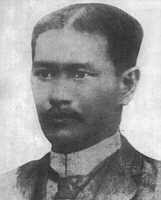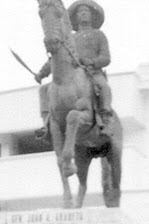The Forgotten “Great” Ilonggo Labor Leader
(By DinggolAranetaDivinagracia - IlonggoNationMovement)

Prologue: “To his comrade-in-arms during their guerrilla warfare in the mountains of Panay against the Japanese Imperial Army, he was the courageous leader; to many exploited lowly laborers in the waterfronts and in the sugar industry and manufacturing companies in the Visayas and in Mindanao, he was the savior.
However, to corporate greed in the big businesses and the corrupt politicians, he was the “Kontrabida”. Was he a hero, a true patriot, and a sincere labor leader, or was he really a social demagogue?” --dinggol.d~~~
Family Background:

Jose Maria Nava was born in Iloilo City on July 31, 1892, to Don Mariano Legaspi Nava and Dña. Estefa Nuñal y Carrera de Nava of Iloilo City. --He was first married to Adela Sevilla Carañeta of Pulupandan, Negros Occidental with whom he had eleven ((11) children, namely; Leon, Ricardo, Julieta, Flavio, Benjamin, Valentin, Sigfredo, Esperanza, Adela, Jose Maria, and Napoleon a.k.a. Batotoy. Sometime in 1934, five (5) years after he became a widower, he remarried to Adelina Aldeguer of La Carlota in Negros Occidental. They have eight (8) children, namely; Lohengrin (Cid), Mario (Tobin), Josef, Sumakwel (Makwel), Jose Ma. (Baby), a daughter Libertad, Franklin (Voodoo), and Jonathan (Toto Tambok).
Educational Background:
Aside from his serious home self-studies, he also attended a public Elementary School, and an Iloilo High School -for his secondary education, and also at the Iloilo Normal School, all in the City of Iloilo, Philippines.
The Arts, Theatrical, Journalistic, Sports and Political Endeavor:
Even at a young age, Nava already showed his loved for the arts, drama, and music by attending private lessons. He also engaged much of his time reading Spanish and American novels. Later, he decided to pursue a career in arts and was enrolled in painting at the School of Fine Arts in Manila. He was so fascinated with literature that he even wrote several notable dramas before returning to Iloilo City in 1914.
Apart from arts and theater, he began a career in editorial in 1915 when he served as a correspondent for the “El Tiempo” a local Spanish paper. At the same time, he was also the editor and publisher of the vernacular paper “ Tingog sang Banwa”. Later he became editor-publisher of “El Tiempo” until it was closed down in 1922. Thereafter, Nava founded and became the publisher of Iloilo’s two sister newspapers, the “Prensa Libre” a Spanish daily, and the “Landasan” a weekly issue in the vernacular.
In the year 1922, he won the shooting championship and was given medal as a “sharpshooter” by the Philippine Rifle and Pistol Association and by the War Department of the U.S.A. He founded the first shooting club in Iloilo; the “Sociedad de Tiro al Blanco de Iloilo.
Jose Ma. Nava dedicated long years of his life to the arts and theater but major setbacks at the peak of his career ended his theatrical profession. He tried his luck in local politics and won twice in Iloilo’s Municipal council. Although he did not fair-well in the field of politics, he gained many successes as a newspaper editor for his daring expose’ and his fearless campaign against vices and corruption in the government.
The Labor Movement in the Philippines

When Jose Ma. Nava reunited with his close Iloilo childhood friend Vicente Ybiernas, they organized --the first labor organization in Iloilo City, the Union Obrera de Iloilo in the year 1917.
In 1928, a work-related accident blinded an eye of a worker of Visayan Stevedoring Company (VSC) in Lapuz of Lapaz district in Iloilo City. The worker was able to successfully claim just compensation from VSC through the help of Jose Ma. Nava “Gratis et Amore”.
Thereafter, on July 31, 1928, a group of laborers and peasant workers from the district petitioned Nava to organize a labor union. And right on that same day, the low-profile Union Obrera de Iloilo (UOI) evolved into the Federacion Obrera de Filipinas (FOF), that eventually became to be the largest trade union in the Philippines.
Nava gained distinction for leading one of the largest strikes in the history of the country’s labor movement and as an active journalist stirred the workers’ and peasants’ clamor for improvement of their conditions through labor unions.
The FOF as a labor group introduced itself in the industrial arena when it organized a major strike in 1930 involving some 3000 stevedores. He also organized strikes at sugar plantations and mills in Negros. In 1939, he was elected the National Chairman of the Collective Labor Movement (CLM) the biggest organization of labor before the outbreak of the war.
The Outbreak of World War II:
During the Japanese occupation, after he contacted Army Major Quimbo and Gen. Bradford Chynoweth, the local commander of the USAFFE, Jose Ma. Nava was outright commissioned as Captain of the USAFFE and become the Chief of the Propaganda Unit and Intelligence Unit under Gen. Macario Peralta, Panay Island Commanding General. His 8 sons and daughters were, likewise, all commissioned in the USAFFE as captains, lieutenants, and privates.
After the fall of Bataan, and USAFFE surrendered to Japan, many of his friends collaborated with the Japanese regime. While Nava, his family, and many FOF members remained loyal to Uncle Sam --in the hinterlands of Panay as Ilonggo guerrilla fighters until the end of the Japanese-American war.
The Post War Era Politics:
On July 4, 1946, Philippine independence was granted by the United States to the war-weary Filipino people on a silver platter with strings attached. While many rejoiced, patriotic leaders of labor and peasant organizations who triumphantly fought the Japanese during the war, especially the “Hukbong ng Bayan Laban sa Hapon” or the HUKBALAHAPS were all vehemently opposed to the Bell Trade Act, the Parity clause for Amendment to the Constitution, and the Military Bases Agreement in exchange for US rehabilitation funding. They believed these as an inexcusable surrender of our national sovereignty.

To secure the majority votes necessary to pass the amendment, President Manuel A. Roxas arranged for the six (6) duly elected members of Congress in 1946 led by Luis Taruc who belong to the opposition party, Democratic Alliance (DA) under Sergio Osmeña, Sr. ejected from their offices by the Commission on Elections on the grounds that they had been committing election fraud and terrorism.
The Collective Labor Movement (CLM) and CLUP
Seven years earlier, on June 29, 1939,at the Manila Grand Opera House, a total of seventy-six (76) labor organizations held a National Convention.
After due deliberation, a resolution creating the Collective Labor Movement (CLM) was approved. A Presidium was formed and the affiliated unions signed a pact to the effect that they would, among other things, stick together through thick and thin.
Elected to the Presidium were: Jose Maria Nava (National Chairman), Isabelo Tejada, Pedro Abad Santos, Mateo del Castillo, Juan Feleo, Luis Taruc, Pedro Castro, Antonio Paguia, Manuel Palacios, Manuel Joven, Mariano Ponce, Florentino Tecson, Mariano Balgos, Rufo Covacha, Luis Pilapil, Luis Adriano, and Guillermo Capadocia as Secretary General.
FOF President, and former CLM National Chairman Jose Ma. Nava allied himself with his pro-worker, pro-peasant, and pro-people group to the consternation of his personal, professional and political detractors.
In 1947 Atty. Pascual “Pascualing” Espinosa, a former vice president of Federacion Obrera de Filipinas (FOF), broke his ties with the FOF group and accepted the leadership of the government-favored “Consolidated Labor Union of the Philippines (CLUP)” based near Muelle Loney in Iloilo City. The two (2) labor unions, the rightest and the leftist became bitter rivals that resulted in violent armed confrontations.
The Twilight Years and the Last Hurrah!
Meanwhile, in 1951, government Militia filed a case against Jose Ma. Nava for his involvement in the 1950 murder of an alleged under-cover government agent. Likewise, he was also linked to the rebellion case of his sons; Ricardo, Flavio a.k.a. “Ugat”, and Napoleon a.k.a. “Batotoy”, and his son-in-law Alfredo Palmejar a.k.a. “Ibarra”; together with his co-labor leader Guillermo Capadocia a.k.a. “Juan Bantiling”, et al. As more violence erupted, Constabulary troops were ordered to secure in detention the then already weak Jose Ma. Nava, and his co-accused at the Iloilo provincial jail on charges of subversion in 1951.
During the trial in the lower court, two of the accused in “absentia”, namely, Guillermo Capadocia the top leader of the Communist movement in Panay was killed in punitive expeditions of the armed forces. And Paterno Patrimonio a.k.a. “Kulafu” leader of the dreaded bandits who plunder and rape, brutally kill and burn huts of even simple farmers along their path.
In April 1952, the Iloilo Regional Trial Court Judge Magno Gatmaitan found him guilty of the accusation and sentenced Jose Ma. Nava to death. After conviction, he was transferred to the Muntinlupa Bilibid Prison (together with son Flavio) where he spent his remaining years writing and reflecting. His poor health condition suffered due to imprisonment and his real estate properties were sold at a bargain because of the lengthy trial.

(Photo of the funeral entourage along Calle Real during Jose Ma. Nava interment in the City of Iloilo)
While waiting for the final judgment of the Supreme Court on his appeal, Jose Ma. Nava died from heart disease on January 14, 1954, at the Manila Sanitarium while on a hospital leave from the Muntinlupa Bilibid Prison.
Thirteen (13) years after the guilty verdict was rendered by the Iloilo lower court, the Supreme Court of the Philippines found the accused innocent beyond reasonable doubt and dismissed the subversion and criminal cases filed against Ilonggo labor leader Jose Ma. Nava and his family.
Accolade from the President of the United States of America

After almost sixty (60) years since the end of world war II, the 42nd US President William “Bill” Jefferson Clinton sent an acknowledgement to the loyal and devoted USAFFEE Captain Jose Maria Nava for his sincere service to the Armed Forces of the United States of America.
Too late the hero, “Better late than never, but better never late” as the saying goes! ~~~
Epilogue: “As a growing kid from age 5 to 10 years old living at No. 19 Valeria Street in Iloilo City, whose family were good neighbors and close friends of the Nava’s, this writer is a living witness to the rise and fall of the greatest Ilonggo labor leader of them all, Don Jose Maria Nava, Sr.
I vividly recall, thousands of serious-faced lowly laborers and peasant workers on parade along Calle Valeria with FOF streamers and red banners, shouting on top of their voice in unison; “Handa kami kon kami ang may pana!” --dinggolSDname~~~
(Nota bene: Salamat! to Jose Marte Nava for some of the precious family photos and info) ~~~



















No comments:
Post a Comment